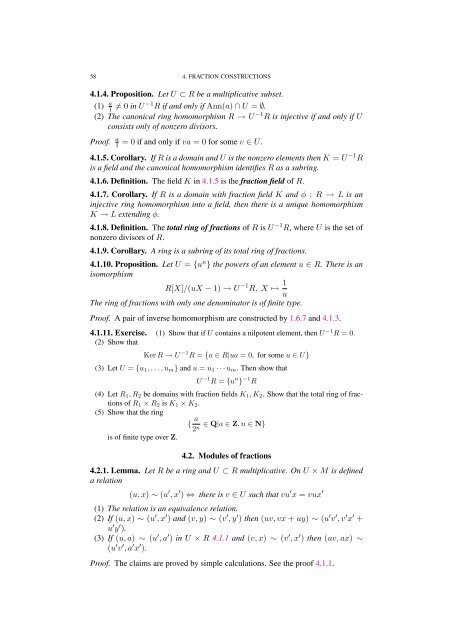Commutative algebra - Department of Mathematical Sciences - old ...
Commutative algebra - Department of Mathematical Sciences - old ...
Commutative algebra - Department of Mathematical Sciences - old ...
Create successful ePaper yourself
Turn your PDF publications into a flip-book with our unique Google optimized e-Paper software.
58 4. FRACTION CONSTRUCTIONS<br />
4.1.4. Proposition. Let U ⊂ R be a multiplicative subset.<br />
(1) a<br />
1 = 0 in U −1R if and only if Ann(a) ∩ U = ∅.<br />
(2) The canonical ring homomorphism R → U −1R is injective if and only if U<br />
consists only <strong>of</strong> nonzero divisors.<br />
Pro<strong>of</strong>. a<br />
1 = 0 if and only if va = 0 for some v ∈ U.<br />
4.1.5. Corollary. If R is a domain and U is the nonzero elements then K = U −1 R<br />
is a field and the canonical homomorphism identifies R as a subring.<br />
4.1.6. Definition. The field K in 4.1.5 is the fraction field <strong>of</strong> R.<br />
4.1.7. Corollary. If R is a domain with fraction field K and φ : R → L is an<br />
injective ring homomorphism into a field, then there is a unique homomorphism<br />
K → L extending φ.<br />
4.1.8. Definition. The total ring <strong>of</strong> fractions <strong>of</strong> R is U −1 R, where U is the set <strong>of</strong><br />
nonzero divisors <strong>of</strong> R.<br />
4.1.9. Corollary. A ring is a subring <strong>of</strong> its total ring <strong>of</strong> fractions.<br />
4.1.10. Proposition. Let U = {u n } the powers <strong>of</strong> an element u ∈ R. There is an<br />
isomorphism<br />
R[X]/(uX − 1) → U −1 R, X ↦→ 1<br />
u<br />
The ring <strong>of</strong> fractions with only one denominator is <strong>of</strong> finite type.<br />
Pro<strong>of</strong>. A pair <strong>of</strong> inverse homomorphism are constructed by 1.6.7 and 4.1.3.<br />
4.1.11. Exercise. (1) Show that if U contains a nilpotent element, then U −1 R = 0.<br />
(2) Show that<br />
Ker R → U −1 R = {a ∈ R|ua = 0, for some u ∈ U}<br />
(3) Let U = {u1, . . . , um} and u = u1 · · · um. Then show that<br />
U −1 R = {u n } −1 R<br />
(4) Let R1, R2 be domains with fraction fields K1, K2. Show that the total ring <strong>of</strong> fractions<br />
<strong>of</strong> R1 × R2 is K1 × K2.<br />
(5) Show that the ring<br />
{ a<br />
∈ Q|a ∈ Z, n ∈ N}<br />
2n is <strong>of</strong> finite type over Z.<br />
4.2. Modules <strong>of</strong> fractions<br />
4.2.1. Lemma. Let R be a ring and U ⊂ R multiplicative. On U × M is defined<br />
a relation<br />
(u, x) ∼ (u ′ , x ′ ) ⇔ there is v ∈ U such that vu ′ x = vux ′<br />
(1) The relation is an equivalence relation.<br />
(2) If (u, x) ∼ (u ′ , x ′ ) and (v, y) ∼ (v ′ , y ′ ) then (uv, vx + uy) ∼ (u ′ v ′ , v ′ x ′ +<br />
u ′ y ′ ).<br />
(3) If (u, a) ∼ (u ′ , a ′ ) in U × R 4.1.1 and (v, x) ∼ (v ′ , x ′ ) then (uv, ax) ∼<br />
(u ′ v ′ , a ′ x ′ ).<br />
Pro<strong>of</strong>. The claims are proved by simple calculations. See the pro<strong>of</strong> 4.1.1.
















